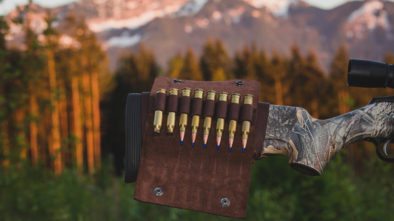Bullet Basics
These days the number of brands claiming to be the best hunting bullet can be overwhelming. Not that the claimants are misleading you, but the fact is shot placement on your game is most important. A bad shot with a great performing bullet is definitely worse than a good shot with an adequate bullet.
Design, shape, and weight are the three important factors to be considered before selecting the bullet.
The metals commonly used for the construction of the projectile are copper, lead, or a combination of metals. Bonding is essential to keep the outer jacket and the inner core firmly bonded. A thicker jacket in game bullets is essential to hold the bullet during penetration whereas bullets used in matches have a thinner jacket, which are more uniform and are also concentric increasing its accuracy. Practice and match bullets are non-expanding and they are illegal for hunting big game in North America. Some manufacturers also make solid bullets of copper alloys or lead alloys these are used in hunting big game.
Generally animals weighing 80 pounds and above (up to 12000 pounds in the case of African elephants) can be classified as big game.
Bullet weight increases with the weight of the animal to be hunted; however a 180-grain bullet is sufficient for almost all the big game animals in North America.
Beginners can select the right caliber hunting bullets using the Winchester’s CXP rating scale.
Various classes of game animals can be described using the Winchester‘s “CXP” (Controlled eXPansion) scale.
Winchester, Remington, Federal, Hornady, and Barnes are some of the big names in ammunition manufacturing and ammunition reloading.
CXP1: includes small predators like woodchuck, coyote, and prairie dogs,and varmints. Usually bullets that fragment or expand on impact are used e.g.
Hornady V-Max, Remington Power-Lokt
CXP2: includes animals like sheep, antelope, goat, and deer. The game weight range is 80 pounds-400 pounds. Rapidly expanding bullets are recommended for this class of animals e.g., Winchester Power Point, Remington Core-Lokt, Federal Hi-Shok, Hornady Interlock
CXP3: this includes animals, which are large and heavy with a weight range of 500-1000 pounds e.g. elk, moose, and brown bear. Bullets used for these animals are typically designed for deeper penetration and delayed controlled expansion e.g. Hornady InterBond, Remington Core-Lokt Ultra, Barnes X-Bullet, Federal Trophy Bonded Bear Claw, and Winchester Fail Safe and Partition Gold, are often recommended. Traditional designs in appropriate calibers like the Winchester Silvertip and Remington Core-Lokt have also proven themselves for many years.
CXP4: These are extremely large animals like American bison, and many African species like elephant, rhino, and cape buffalo weighing anywhere from 1000 pounds to 12000 pounds. Heavily constructed expanding bullets for maximum penetration are used e.g. Barnes X-Bullet.
These ratings do not cover all the possibilities but are a good starting point for a beginner to make the right choice of bullets depending on the game.
Generally bullet weights are available from 85 grains with 10-grain increments
Some popular configurations and shapes are: –
Boat Tail
BT – Boattail (pointed tip with the perimeter of the base angled inward)
BTHP – Boattail hollow point (boattail with a hollow-point tip)
Cast bullet
CB – Cast bullet (jacketless and cast from a single metal or alloy)
Full metal jacket
FMJ – Full metal jacket (bullet core enveloped in a jacket except for base)
Flat nose
FN – Flat nose (projectile with a very flat front)
Flat point
FP – Flat point (tip tapers somewhat to a flat point)
Hollow point
HP – Hollow point (tip has an open cavity for rapid expansion)
Jacketed flat point
JFP – Jacketed flat point (sides are fully jacketed to an exposed flat tip)
Jacketed hollow point
JHP – Jacketed hollow point (sides are fully jacketed to a hollow-point tip)
Jacketed soft point
JSP – Jacketed soft point (sides are fully jacketed to an exposed lead tip)
Pointed soft point
PSP – Pointed soft point (bullet tapers to a sharp, softer metal tip)
Round nose
RN – Round nose (front of bullet is very rounded)
Round nose flat point
RNFP – Round nose flat point (bullet front rounds to a sudden flat point)
Round nosed lead
RNL – Round nosed lead (round nose bullet made of lead or lead alloy)
Semi-jacketed
SJ – Semi-jacketed (metal jacket extends only part way up bullet sides)
Semi-jacketed hollow point
SJHP – Semi-jacketed hollow point (hollow point partially jacketed)
Semi-jacketed soft point
SJSP – Semi-jacketed soft point (soft point partially enclosed in a jacket)
Soft point
SP – Soft point (bullet with a tip made of softer metal for rapid expansion)
Spitzer
SPTZ – Spitzer (a pointed bullet with a flat, untapered base)
In any given caliber, lighter bullets are intended for smaller animals and heavier bullets are intended for dangerous and larger animals.
Most hunters have a misconception that the heavier the bullet the less likely it is affected by the wind but the opposite is true, the heavier bullet though maintains its momentum better is slow giving the wind more chance to push it off course.
A correctly chosen bullet for the type of game being hunted and the shot placed at the right place will definitely do its job.
Any Cincinnati gun crime lawyer knows all the Ohio firearm codes and charges but may not know the difference between bullets for hunting and personal defense. Handguns are used in the majority of gun crimes and often use 9mm rounds.


